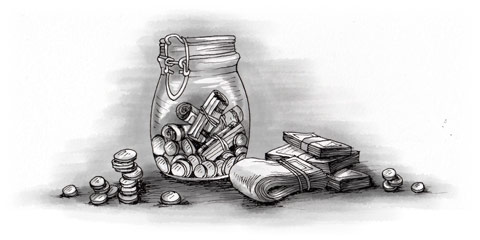If you have a Chilean bank account, it is common to receive a cheque book which Chileans use often. For international cheques it is more complicated since you need to change the cheque in an associated bank.
As for travelers’ cheques, they are difficult to exchange and when they are, the rates are not good. You can carry them as a back-up, but using funds from a debit account is more practical. If possible pay with cash as some businesses charge up to 6% extra for a credit card transaction.
ATMs in Chile
In Chile, there is a wide network of ATMs, divided into three sub-networks: Redf, Redbanc and BancoEstado. The last two are now connected.
The maximum withdrawal allowed is CL$200,000, although some ATMs in the Redf network allow you to withdraw up to CL$800,000 thanks to a biometric security system that identifies your digital fingerprint.
With this system, clients are allowed to make cash deposit or validate cheque payments. Other facilities are phone and transport card top-ups and international money transfers, although these facilities may only be for clients.
Exchanging money
If you need to exchange money, Santiago is probably the best place for it. Exchange shops are everywhere and sometimes one next to each other, giving an extremely small margin between the buy / sell rate, but often with bigger commissions than banks.
It’s possible to pay in US dollars in some places, especially for large amounts in tourist areas, such as paying a hotel bill or for a tour.
When exchanging money or cheques, AFEX is a good option. They exchange from and to any currency, although a registration is required the first time for exchanging cheques and cash amounts higher than US$3,000. For smaller amounts, an ID card or passport will be required.
Transferring money within Chile and abroad
Within Chile, the most common ways to transfer money are either through a money order or a bank transfer. Now that most banks offer online banking, online transfers are widely used but transfer times are still on the slow side.
Within the country, a money transfer can take up to a couple of days to arrive. If the transfer is within the same bank it is generally quicker.
If you have a Chilean bank account, you should know that RUT accounts and other similar services sometimes are not designed for wiring money abroad and often you will not be able to use them for it. If you are able to, you should expect to pay a fee of 2% of the total you are sending or US$50 (whichever is more).
Chile only accepts USD, GBP or EUR for international transfers so if you have another currency, you will need to change it twice. Also, banks often charge for receiving money from an international account but the fee varies depending on the amount.
An alternative is to use international money transfer agents such as Western Union, Oanda, AFEX or Chile Express (the last two are well-known everywhere in Chile). These, as well as the bureaux d’exchange, will give you a better rate for your money.
Another option, if you have less than US$10,000 is to carry it with you by plane but be careful! Whether you wire US$10,000 or you carry it, it could be considered structuring , a form of money laundering.

